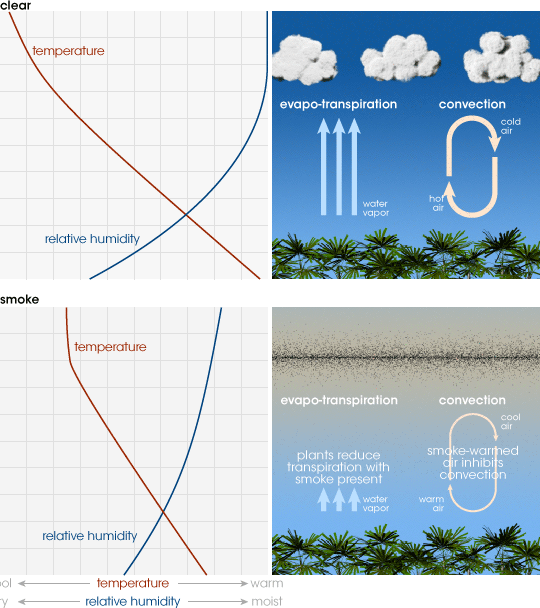

Aerosols: Particles of Many Personalities | |||
Koren’s search through the scientific literature yielded two leads. In a 1997 paper titled “The Missing Climate Forcing,” James Hansen, of NASA’s Goddard Institute for Space Studies, and co-authors described their efforts to construct a global climate model in which they accounted for various components in the Earth system that exert warming and cooling influences. The authors stated that, on a global scale, aerosols’ overall effect is to cool the planet. Even more substantial than aerosols’ indirect cooling effect (making clouds more reflective) is the way in which the tiny particles directly scatter and reflect incoming sunlight back to space. Called the “direct effect,” aerosols also cool by reducing the amount of sunlight reaching the surface. (See sidebar at right.) |
|||
 |

Aerosols in the stratosphere increase the Earth’s reflectivity, causing cooling. The eruptions of the El Chichon (1982) and Mount Pinatubo (1991) volcanoes placed sulfate aerosols in the stratosphere (the blue line represents stratospheric aerosol concentration). It took several years for the aerosols to be flushed out of the atmosphere, and during that time the Earth experienced slight cooling (the red line represents average global surface temperature). (Graph by Robert Simmon, based on data from the Goddard Institute for Space Studies) In addition to the indirect and direct cooling effects of aerosols, Hansen and his co-authors also predicted a significant third way in which aerosols can influence climate. They called it the “semi-direct aerosol effect on clouds”—the process by which dark-colored aerosol particles (i.e., the soot in smoke) absorb incoming sunlight and warm the atmosphere relative to the temperature of the surface. The net effect of this atmospheric warming, they hypothesized, would be to reduce the upward movement of moisture and, in turn, reduce cloud cover. The authors’ theory seemed to match what Koren saw in the MODIS images over the Amazon, and what Ramanathan observed flying over the Indian Ocean. Koren’s second lead was another paper published in 2000, entitled “Reduction of Tropical Cloudiness by Soot.” In that study Andy Ackerman, of NASA’s Ames Research Center, and co-authors used a computer model to demonstrate that energy-absorbing aerosols can have a semi-direct affect on cumulus clouds over the ocean. At the time he wrote his paper, Ackerman was unaware of Hansen’s paper and so he wasn’t familiar with Hansen’s term “semi-direct effect.” Instead, Ackerman described it as the “cloud-burning effect of soot.” But both groups of scientists described the basic underlying physics of the process in pretty much the same way: as the top of the boundary layer becomes filled with dark-colored particles (like soot), the aerosols absorb sunlight and warm the temperature of the air relative to the temperature of the surface. According to Ackerman, this heating at the top of the boundary layer burns away clouds in two ways: (1) by accelerating the process of evaporation of existing clouds, and (2) by suppressing the upward flow of moisture from the surface needed to form new clouds. |
||
 |
 |
||
“Up to that point, most people were thinking about how aerosols [through both their direct and indirect effects] oppose the warming due to greenhouse gas forcing,” Ackerman recalled. “But we found aerosols can also amplify the greenhouse forcing. Fewer clouds means more solar energy enters the Earth system, which amplifies the warming effect of carbon dioxide.” The papers confirmed Koren’s suspicions about what he observed in the Aqua satellite data acquired over the Amazon Basin—the smoke was suppressing the formation of low-level cumulus clouds. The next obvious question was just how strong an influence do aerosols exert on Earth’s radiant energy budget through their semi-direct effect? Pursuing the answer to this question put Koren on the path toward a new goal: measure the semi-direct effect of smoke aerosols on the Earth’s energy budget. |
The presence of smoke over the Amazon alters the atmosphere in a number of ways that reduce cloud cover. In clear conditions (top) temperature (red line) gradually decreases with altitude, which in turn increases relative humidity (blue line). At the “boundary layer” relative humidity reaches 100 percent, and moisture condenses out of the air, forming clouds. Additionally, the trees transpire (during photosynthesis), releasing water vapor. Sunlight also warms the surface, creating warm air that rises, then cools and falls back to the surface in the process of convection. When smoke is present, the dark soot particles absorb sunlight, heating the atmosphere and cooling the surface. This heating reduces relative humidity in the smoke layer, inhibiting the formation of clouds. Furthermore, plants reduce transpiration in response to the smoke, which lowers the amount of water vapor in the air. Because the smoke warms the air above the surface, and simultaneously cools the surface, the difference in temperature between the upper layer of air and air near the surface is reduced, limiting convection, and further discouraging cloud formation. (Graphs and Illustrations by Robert Simmon) | ||